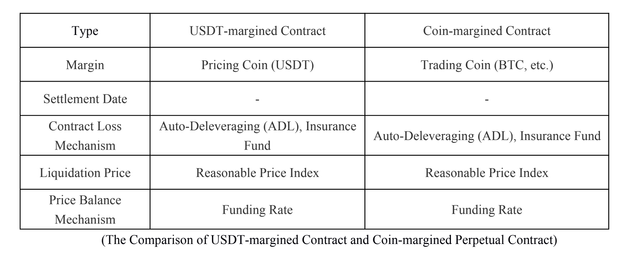CoinEx Tutorial: What Is a Coin-margined Contract?
Similar to a USDT-margined contract, a coin-margined contract is part of the perpetual contract, and is also known as the inverse contract. The biggest difference between the two lies in the selection of margin: unlike USDT-margined contracts that use the pricing currency USDT as a margin, coin-margined contracts apply trading currencies such as BTC and ETH.
In the case of coin-margined contracts, users need to hold the corresponding coin before they can participate in transactions in the contract market. For example, in BTCUSD-margined contracts, users need to transfer BTC as a margin. Simply put, you need to transfer the specific coin and earn that coin in a coin-margined contract.
USDT-margined contracts and coin-margined contracts share one thing in common: the spot market price is anchored in the mechanics of a funding component in a perpetual contract. Contracts allow you to buy for long or sell for short based on your predictions about the future upside and downside of the prices to gain profits. CoinEx offers perpetual contract trading around the clock, with no expiry or settlement date.

You may be confused about the funding fee and the funding rate. So what is a funding rate?
The funding fee is not the fee charged by CoinEx (that is, CoinEx is not involved), but something between users. The funding system ensures the market price near the spot index price for perpetual trading, and the funding rate, below or above zero, determines who needs to pay.
CoinEx introduced the funding system to anchor the market price to the spot price. When the contract price is higher than the spot price (that is, the funding rate is positive), long positions will pay the funding to short position holders with the exact amount, thus lowering the price; if the contract price is lower than the spot price (that is, the funding rate is negative), long position holders will receive it, thus pushing up the price.
In this way, the funding rate can keep the contract price consistent with the spot price as much as possible, even with a certain deviation. The funding will be paid/received every 8 hours, and it only takes place in specific timestamps, i.e. 0:00, 08:00, and 16:00 (UTC). Besides, in the case of forced liquidation, CoinEx will relieve users’ losses through the contract loss mechanism such as the insurance fund and Auto-Deleveraging (ADL).
For the time being, BTCUSD, ETHUSD, DOGEUSD, and ADAUSD contract markets are supported for coin-margined contracts on CoinEx, with up to 10X margin available. Users can choose the contract market and margin ratio as needed, and transfer the corresponding coin as the margin to participate in contract trading.
So what kind of users will find coin-margined contracts friendly?
For newcomers with only stablecoins in hand, USDT-margined contracts will be a better choice for two reasons: first, contract trading requires USDT only; second, thanks to the relatively stable value of USDT, the profits and losses will be clearer.
But if a user has BTC, ETH or other cryptocurrencies and is experienced in contract trading, he or she may open a position with the coin-margined contract. When the market booms, the coin-margined contract will increase the coin price and returns as well; but it will also saddle you with amplified losses when the market moves against you.
Last but not the least, contract trading comes with risks. You’d better think twice before trading contracts you’re not familiar with when you know little about the market.
When the contract price is higher than the spot price, long positions will pay the funding to short position holders with the exact amount, therefore lowering the price.